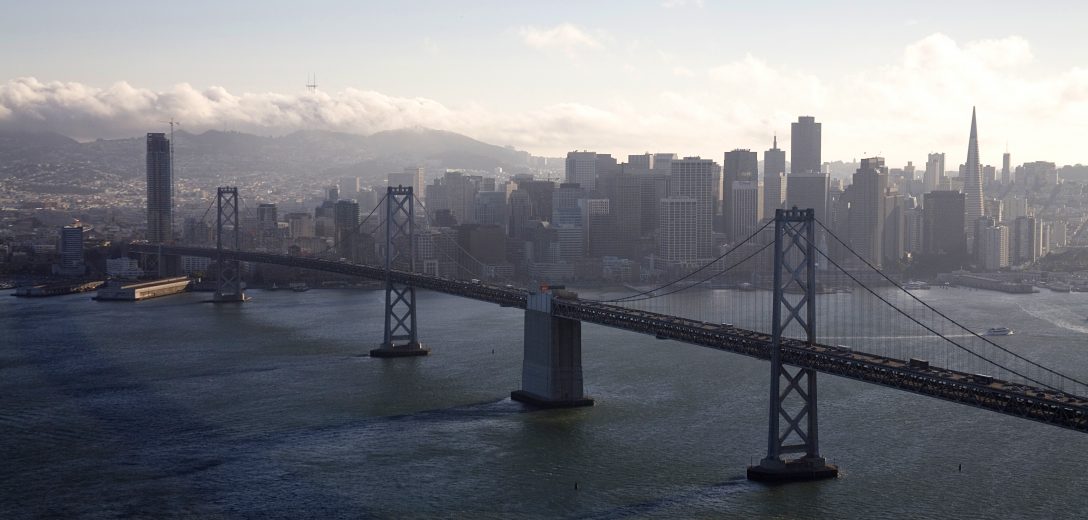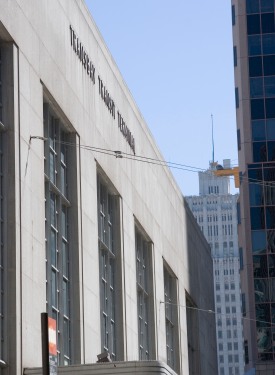
With the looming demolition of the Transbay Terminal approaching next month, one might expect to see the inevitable stories about the building’s better days in the local press. Sadly, the Sunday piece by Carl Nolte in the San Francisco Chronicle does not do the building justice. Too many have judged the 1939 building’s architectural merits by its current grimy appearance: its central hall cut up to accommodate bus station escalators, the built-up filth on its once-sparkling white granite after years of neglect, and the hordes of homeless people who have been allowed to call it home. Originally designed as the terminus for the Key System trains that traveled on the lower deck of the Bay Bridge, the building, designed by a triumvirate of architects led by Timothy Pflueger, deserves a proper homage.
Nolte wrote that “no historian is going to miss this building.” I beg to differ. Some architects, architectural historians and preservationists who spoke with or emailed me agree that the demolition of the former train station will be a major loss for the city. The Chronicle’s own rabble-rouser, its Pulitzer Prize-winning architecture critic, the late Allan Temko, gave the building high praise in an article on September 11, 1978, calling the building “one of the best examples of 1930s Moderne in San Francisco.” He also noted that the building fits historically with the Bay Bridge, even though it was completed three years after the bridge opened.

The Bauhaus-inspired building is unusually spare in its use of ornament. It was especially spare for Pflueger, even though he was beginning to embrace a more streamlined style during this austere period. It was also one of the more modern buildings designed by fellow architect Arthur Brown, Jr., whose luscious Baroque sensibility remains with us today in San Francisco City Hall. John Donovan was the third local architect in the group.
The utilitarian Transbay’s spare detailing is its aluminum frames around the large, industrial windows, which, when clean, filled the grand hall with light as train commuters scurried through. Pflueger had also used a similar pattern in the window frames of his San Francisco Stock Exchange Tower at 155 Sansome Street, ten years earlier. In the case of the Transbay, the lack of ornament or any art work — often added to public buildings during the 1930s thanks to President Franklin Roosevelt’s New Deal projects — was probably due to budgetary constraints. As is noted in my book Art Deco San Francisco, the architects, especially Pflueger, fought frequently with the engineers over efforts to try and add art, ornament or style to the Bay Bridge project. There were also many windows and doors in the terminal, to speed commuters in and out, so there was little wall space for the kind of murals inside the main Transbay building that helped saved the Rincon Post Office Annex from destruction.
The Transbay Terminal has been allowed to deteriorate by its owners. Today, Caltrans and the Transbay Joint Powers Authority, in a seemingly hypocritically move, are celebrating the building through a series of tours for the public. We will be able to visit places that some of us have never seen, such as the Cuddles Bar, the Terminal Jail, the shoeshine stand and the smoke shop. But for long-time commuters through the station, the tours will surely be bittersweet.

“I think the Transbay Terminal has gotten a bum rap over the years, for a number of reasons,” said Christopher VerPlanck, a principal with Knapp & VerPlanck Preservation Architects in San Francisco. “First, Caltrans does not maintain it – it is filthy, badly lit, and perceived rightly or wrongly as being dangerous. Second, I don’t think most Americans appreciate the modernistic aesthetic of the main building or industrial/utilitarian aesthetic of the remainder of the structure.”
VerPlanck loves the Streamline Moderne waiting room and facade and the riveted steel structure of the bus shed and viaduct. “I can’t help but wonder if it would have been perceived more favorably if it had been cleaned regularly and maintained,” he said.
H. Lynn Harrison, an architect who is also the preservation director for the Art Deco Society of California, said he recently went to just look at the elegance of the large windows from indoors, and to try and imagine it in its grander days. “The Transbay Terminal was and still is a beautiful building, modern and classic at the same time,” Harrison said. “It’s sleekness, its strength, its elegance of proportions, all make this an architectural master work.”
Yes, many complain about the low ceilings in the waiting areas and passages, and Nolte described the space as cold and windswept in summer and winter fogs. But Joyce Roy, a semi-retired architect who is also a transit advocate, said she believed that the low ceilings, while designed to make people move faster, were also possibly a page from Frank Lloyd Wright, who often had visitors enter a compressed space with a low ceiling, before going into a dramatic, spacious open area. Wright used this trick in much of his work, especially his homes and churches. It was at Roy’s suggestion that Caltrans decided to open the building to the public for a last tour on Friday. We will report back with photos and other observations.
A spokeswoman for the Transbay Joint Powers Authority said the old terminal is not suited to modern transportation needs. It is ironic that as California tries to re-embrace train travel, San Francisco’s old terminal was deemed as unsuitable for reuse as its original purpose. And even though Caltrans had determined the building was eligible for the National Register of Historic Places, it never pursued that status. Incorporating the old building in the design of the new terminal seems to have been rejected early on, although Roy said it was considered.
“The current terminal is outdated, not up to current seismic safety codes and does not meet the current or future transportation needs of the city or region, which is why it must be replaced,” a spokeswoman for the TJPA said in an email.
Meanwhile, Los Angeles managed to renovate and restore its lovely Union Station, also completed in 1939 and designed by father and son architects Parkinson & Parkinson. It’s a bit mind-boggling that car-centric Los Angeles cares more for its historic train station than allegedly green San Francisco, which is also spending a minimum of $10 million on the demolition of the Transbay Terminal alone, a project that will create some serious debris for landfills.



May be you are right.I think it is a good archive.Thank you!
This is a great website you have! Wonderful job!
People used to know how to make a good urban city with a special charm. Sadly I don’t get any romantic feeling in our modern cities. I wish I lived 50 years ago:)
Merci pour posté cette article. J’aime bien Christophe.
I spent an hour visiting the Terminal today. It was a lot of fun. The place was full of people with cameras being led around by excited tour guides. It was a great time.
I think it is a terrible mistake to tear this building down. Before I came across the Poletti book I had not been into the Terminal and I thought it was a hideous building. Now that I have an appreciation of its history, I think it is a beautiful building, albeit destroyed on the inside.
I’d like there to be a post-mortem on why this building was allowed to be torn down and not saved. It should have been saved years ago after the earthquake. Maybe if the economy had gone south a few years earlier they would’ve canned the new construction and gone in for a restoration.
I too think this is a real loss. A new underground train station could have been built next door or better yet under a street and connected via passageway.
I really like the layout and circulation and how the buses and streetcars drop off/pick up on an elevated loop out front, only steps from elevated tracks/busway. I like how the buses/trains looped around (no stub ended terminal) and was designed to handle huge crowds and lots of trains arriving at once. We could never design something like this today. Sure the waiting room on the first floor is an issue. But this was for local transit travel not long distance intercity travel so its not a big deal.
I’d love to see some floor plans for this building if you ever come upon them.
Thank you for this post. As a person very interested in urban architecture, transportation, and San Francisco history, I too wish more had been done to keep up this structure.
In recent decades, Caltrans (as well as most state DOTs) seems to focus almost exclusively on building new freeways. It’s unfortunate that they couldn’t find room in their portfolio to maintain this structure. I’m optimistic that the new TJPA will be a better steward of our investment in transit infrastructure, and I hope we aren’t doing this again in 60 years.